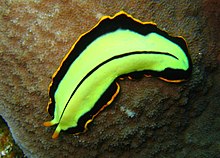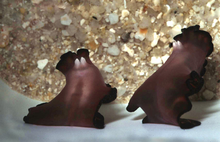Flatworm
| Flatworm Temporal range:
| |
|---|---|

| |
| In a spiral, starting from top left: trematodes), Pseudobiceros hancockanus (Turbellaria )
| |
| Scientific classification | |
| Domain: | Eukaryota |
| Kingdom: | Animalia |
| Subkingdom: | Eumetazoa |
| Clade: | ParaHoxozoa |
| Clade: | Bilateria |
| Clade: | Nephrozoa |
| (unranked): | Protostomia |
| (unranked): | Spiralia |
| Clade: | Rouphozoa
|
| Phylum: | Platyhelminthes Claus, 1887 |
| Classes | |
|
Traditional: Phylogenetic: | |
| Synonyms | |
| |
The flatworms, flat worms, Platyhelminthes, or platyhelminths (from the
In traditional medicinal texts, Platyhelminthes are divided into
Because they do not have internal body
Two planarian species have been used successfully in the
Description

Distinguishing features
Platyhelminthes are
| Attribute | Ctenophores[6] |
More "advanced" bilaterians[15] | |
|---|---|---|---|
| Bilateral symmetry | No | Yes | |
| Number of main cell layers | Two, with jelly-like layer between them (mesoglea) | Three | |
| Distinct brain | No | Yes | |
| Specialized digestive system
|
No | Yes | |
| Specialized excretory system | No | Yes | |
| Body cavity containing internal organs | No | Yes | |
| Specialized organs
|
No | Yes | |
Features common to all subgroups
The lack of circulatory and respiratory organs limits platyhelminths to sizes and shapes that enable
The space between the skin and gut is filled with mesenchyme, also known as parenchyma, a connective tissue made of cells and reinforced by collagen fibers that act as a type of skeleton, providing attachment points for muscles. The mesenchyme contains all the internal organs and allows the passage of oxygen, nutrients and waste products. It consists of two main types of cell: fixed cells, some of which have fluid-filled vacuoles; and stem cells, which can transform into any other type of cell, and are used in regenerating tissues after injury or asexual reproduction.[5]
Most platyhelminths have no anus and regurgitate undigested material through the mouth. The genus Paracatenula, whose members include tiny flatworms living in symbiosis with bacteria, is even missing a mouth and a gut.[16] However, some long species have an anus and some with complex, branched guts have more than one anus, since excretion only through the mouth would be difficult for them.[13] The gut is lined with a single layer of endodermal cells that absorb and digest food. Some species break up and soften food first by secreting enzymes in the gut or pharynx (throat).[5]
All animals need to keep the
In all platyhelminths, the nervous system is concentrated at the head end. Other platyhelminths have rings of ganglia in the head and main nerve trunks running along their bodies.[5][13]
Major subgroups
Early classification divided the flatworms in four groups: Turbellaria, Trematoda, Monogenea and Cestoda. This classification had long been recognized to be artificial, and in 1985, Ehlers
Turbellaria


These have about 4,500 species,
Some turbellarians have a simple pharynx lined with cilia and generally feed by using cilia to sweep food particles and small prey into their mouths, which are usually in the middle of their undersides. Most other turbellarians have a pharynx that is eversible (can be extended by being turned inside-out), and the mouths of different species can be anywhere along the underside.[5] The freshwater species Microstomum caudatum can open its mouth almost as wide as its body is long, to swallow prey about as large as itself.[13] Predatory species in suborder Kalyptorhynchia often have a muscular pharynx equipped with hooks or teeth used for seizing prey.[25]
Most turbellarians have pigment-cup
Planarians, a subgroup of seriates, are famous for their ability to regenerate if divided by cuts across their bodies. Experiments show that (in fragments that do not already have a head) a new head grows most quickly on those fragments which were originally located closest to the original head. This suggests the growth of a head is controlled by a chemical whose concentration diminishes throughout the organism, from head to tail. Many turbellarians clone themselves by transverse or longitudinal division, whilst others, reproduce by budding.[13]
The vast majority of turbellarians are hermaphrodites (they have both female and male reproductive cells) which fertilize eggs internally by copulation.[13] Some of the larger aquatic species mate by penis fencing – a duel in which each tries to impregnate the other, and the loser adopts the female role of developing the eggs.[26] In most species, "miniature adults" emerge when the eggs hatch, but a few large species produce plankton-like larvae.[13]
Trematoda
These parasites' name refers to the cavities in their
Digenea

These are often called flukes, as most have flat
Adults range between 0.2 mm (0.0079 in) and 6 mm (0.24 in) in length. Individual adult digeneans are of a single sex, and in some species slender females live in enclosed grooves that run along the bodies of the males, partially emerging to lay eggs. In all species the adults have complex reproductive systems, capable of producing between 10,000 and 100,000 times as many eggs as a free-living flatworm. In addition, the intermediate stages that live in snails reproduce asexually.[13]
Adults of different species infest different parts of the definitive host - for example the
Aspidogastrea
Members of this small group have either a single divided sucker or a row of suckers that cover the underside.
Cercomeromorpha
These parasites attach themselves to their hosts by means of disks that bear crescent-shaped hooks. They are divided into the Monogenea and Cestoda groupings.[13]
Monogenea

Of about 1,100 species of
Cestoda
These are often called tapeworms because of their flat, slender but very long bodies – the name "
In the majority of species, known as eucestodes ("true tapeworms"), the neck produces a chain of segments called proglottids via a process known as strobilation. As a result, the most mature proglottids are furthest from the scolex. Adults of Taenia saginata, which infests humans, can form proglottid chains over 20 metres (66 ft) long, although 4 metres (13 ft) is more typical. Each proglottid has both male and female reproductive organs. If the host's gut contains two or more adults of the same cestode species they generally fertilize each other, however, proglottids of the same worm can fertilize each other and even themselves. When the eggs are fully developed, the proglottids separate and are excreted by the host. The eucestode life cycle is less complex than that of digeneans, but varies depending on the species. For example:
- Adults of hemocoel (an internal cavity which is the central part of the circulatory system) where it attaches itself using three small hooks. If the copepod is eaten by a fish, the larva metamorphoses into a small, unsegmented tapeworm, drills through to the gut and grows into an adult.[13]
- Various species of Taenia infest the guts of humans, cats and dogs. The juveniles use herbivores – such as pigs, cattle and rabbits – as intermediate hosts. Excreted proglottids release eggs that stick to grass leaves and hatch after being swallowed by a herbivore. The larva then makes its way to the herbivore's muscle tissue, where it metamorphoses into an oval worm about 10 millimetres (0.39 in) long, with a scolex that is kept internally. When the definitive host eats infested raw or undercooked meat from an intermediate host, the worm's scolex pops out and attaches itself to the gut, when the adult tapeworm develops.[13]
Members of the smaller group known as Cestodaria have no scolex, do not produce proglottids, and have body shapes similar to those of diageneans. Cestodarians parasitize fish and turtles.[5]
Classification and evolutionary relationships
The relationships of Platyhelminthes to other Bilateria are shown in the phylogenetic tree:[20]
| Bilateria |
| ||||||||||||||||||||||||||||||||||||
The internal relationships of Platyhelminthes are shown below. The tree is not fully resolved.[29][30][31]
| Platyhelminthes |
| |||||||||||||||||||||||||||||||||||||||||||||||||||||||||||||||||||||||||||
The oldest confidently identified parasitic flatworm fossils are
The "traditional" view before the 1990s was that Platyhelminthes formed the
Detailed morphological analyses of anatomical features in the mid-1980s, as well as molecular phylogenetics analyses since 2000 using different sections of DNA, agree that Acoelomorpha, consisting of Acoela (traditionally regarded as very simple "turbellarians"[13]) and Nemertodermatida (another small group previously classified as "turbellarians"[19]) are the sister group to all other bilaterians.[20][21] However, a 2007 study concluded that Acoela and Nemertodermatida were two distinct groups of bilaterians.[22]
Xenoturbella, a bilaterian whose only well-defined organ is a statocyst, was originally classified as a "primitive turbellarian".[23] Later studies suggested it may instead be a deuterostome,[24][36] but more detailed molecular phylogenetics have led to its classification as sister-group to the Acoelomorpha.[37]
The Platyhelminthes excluding Acoelomorpha contain two main groups - Catenulida and Rhabditophora - both of which are generally agreed to be monophyletic (each contains all and only the descendants of an ancestor that is a member of the same group).[21][29] Early molecular phylogenetics analyses of the Catenulida and Rhabditophora left uncertainties about whether these could be combined in a single monophyletic group; a study in 2008 concluded that they could, therefore Platyhelminthes could be redefined as Catenulida plus Rhabditophora, excluding the Acoelomorpha.[21]
Other molecular phylogenetics analyses agree the redefined Platyhelminthes are most closely related to
It has been agreed since 1985 that each of the wholly parasitic platyhelminth groups (
Evolution
An outline of the origins of the parasitic lifestyle has been proposed;[41] epithelial feeding monopisthocotyleans on fish hosts are basal in the Neodermata and were the first shift to parasitism from free living ancestors. The next evolutionary step was a dietary change from epithelium to blood. The last common ancestor of Digenea + Cestoda was monogenean and most likely sanguinivorous.
In several members of the order Rhabdocoela an endosymbiotic relationship with microalgae has evolved. Some species in the same order has also evolved kleptoplasty.[42]
The earliest known fossils confidently classified as tapeworms have been dated to 270 million years ago, after being found in
Interaction with humans
Parasitism

In 2000, an estimated 45 million people were infected with the beef tapeworm
The threat to humans in developed countries is rising as a result of social trends: the increase in
Pests
There is concern in northwest Europe (including the British Isles) regarding the possible proliferation of the New Zealand
Benefits
In Hawaii, the planarian
A study in Argentina shows the potential for planarians such as
See also
References
- ^ PMID 23383033.
- ^ .
- ^ S2CID 134814852.
- ^ )
- ^ ISBN 978-0-19-551368-4.
- ^ ISBN 978-0-19-551368-4.
- ^ ISBN 978-0-632-04917-2. Archivedfrom the original on 2023-03-23. Retrieved 2008-12-21.
- S2CID 85570246.
- hdl:11380/1179356.
- PMID 26598722.
- PMID 26138503.
- PMID 31178892.
- ^ ISBN 978-0-03-025982-1.
- ^ )
- ^ ISBN 978-0-03-025982-1.
- ^ "This Seabed Flatworm Got Rid Of Its Mouth And Anus, Replacing Its Entire Digestive System With Bacteria". 8 April 2019. Archived from the original on 2022-12-11. Retrieved 2022-12-11.
- ^ Ehlers U. (1985). "Phylogenetic relationships within the Plathelminthes", pp 143–158 in The Origins and Relationships of Lower Invertebrates. S Conway Morris, JD George, R Gibson, HM Platt (eds.). Clarendon Press, Oxford.
- )
- ^ S2CID 84015834.
- ^ (PDF) from the original on 2017-06-11. Retrieved 2010-10-28.
- ^ .
- ^ S2CID 85599100.
- ^ a b Westblad, E. (1949). "Xenoturbella bocki n.g., n.sp., a peculiar, primitive turbellarian type". Arkiv för Zoologi. 1: 3–29.
- ^ S2CID 4413357.
- ^ Evolution and Functional Morphology of the Proboscis in Kalyptorhynchia (Platyhelminthes)
- PBS. Archivedfrom the original on 2013-11-14. Retrieved 2008-12-21.
- ^ a b The Carter Center. "Schistosomiasis Control Program". Archived from the original on 2008-07-20. Retrieved 2008-07-17.
- PMID 24278118.
- ^ ISBN 978-0-19-517234-8. Archivedfrom the original on 2023-03-23. Retrieved 2020-11-11.
- .
- PMID 25866392.
- )
- JSTOR 3227067.
- PMID 9159926.
- ^ A global metabarcoding analysis expands molecular diversity of Platyhelminthes and reveals novel early-branching clades
- S2CID 4366885.
- S2CID 205247296.
- ^ S2CID 85917387. Archived from the original(PDF) on 2011-10-06. Retrieved 2008-12-23.
- .
- S2CID 6018712.
- PMID 20493870.
- ^ A new case of kleptoplasty in animals: Marine flatworms steal functional plastids from diatoms
- (PDF) from the original on 2022-07-30. Retrieved 2022-07-15.
- ^ PMID 10885116.
- PMID 12932389.
- PMID 3501340. Archived from the original(PDF) on 2009-08-16. Retrieved 2008-12-24.
- S2CID 221733822.
- Today (U.S. TV program). 2013-08-16. Archivedfrom the original on 2017-11-07. Retrieved 2013-09-22.
- ^ "Flatworm information sheet – Isle of Man Government" (PDF). Archived from the original (PDF) on 2013-05-01. Retrieved 2014-05-26.
- ISSN 1051-0761.
- ISBN 978-0-85199-319-5. Archivedfrom the original on 2023-03-23. Retrieved 2020-11-11.
- PMID 24688873.
- .
Further reading
- Campbell, Neil A. (1996). Biology (Fourth ed.). New York: Benjamin/Cummings Publishing. p. 599. ISBN 0-8053-1957-3.
- Crawley, John L.; van de Graff, Kent M., eds. (2002). A Photographic Atlas for the Zoology Laboratory (Fourth ed.). Colorado: Morton Publishing Company. ISBN 0-89582-613-5.
- The Columbia Electronic Encyclopedia (6th ed.). Columbia University Press. 2004. Retrieved 8 February 2005.
- Evers, Christine A.; Starr, Lisa (2006). Biology: Concepts and Applications (6th ed.). United States: Thomson. ISBN 0-534-46224-3.
- Saló, E.; Pineda, D.; Marsal, M.; Gonzalez, J.; Gremigni, V.; Batistoni, R. (2002). "Genetic network of the eye in Platyhelminthes: Expression and functional analysis of some players during planarian regeneration". Gene. 287 (1–2): 67–74. PMID 11992724.
